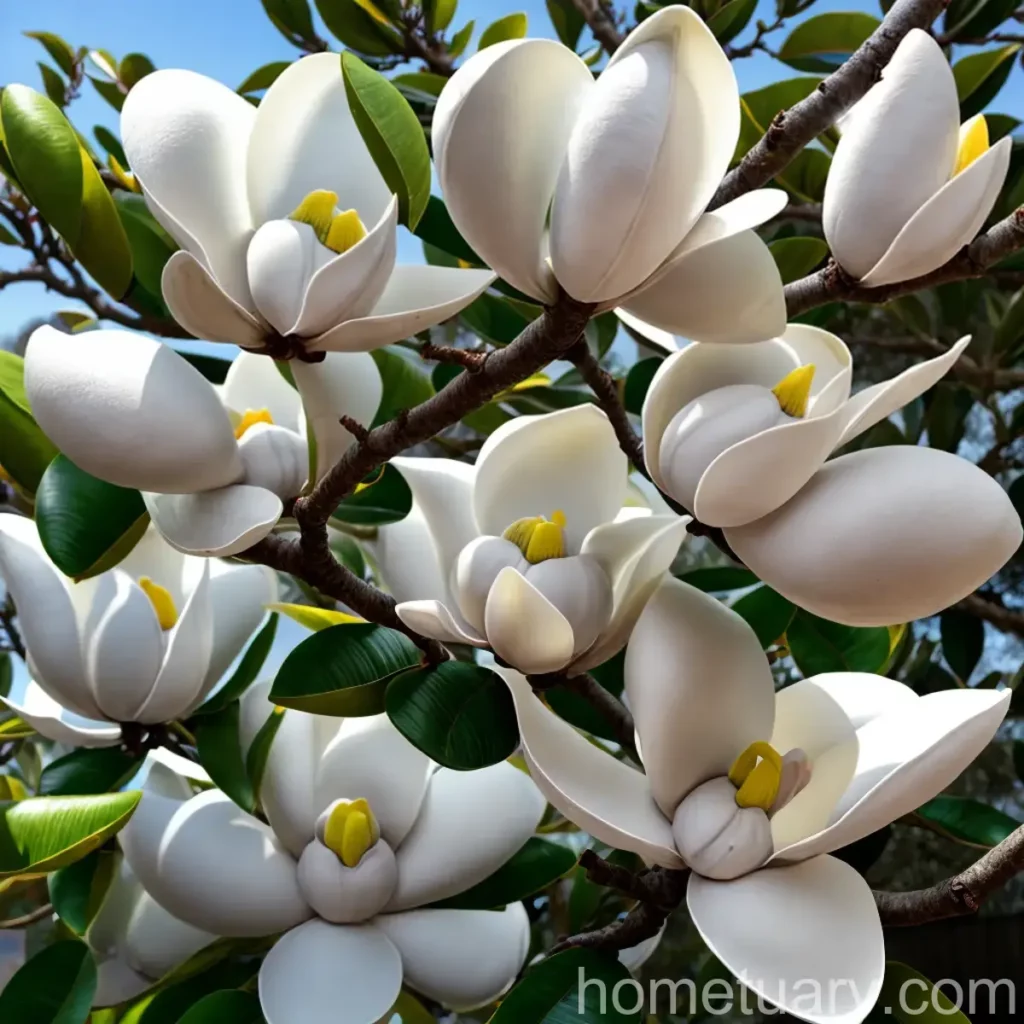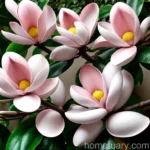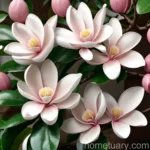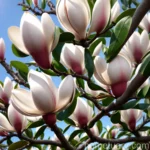Sweet Bay Magnolia (Magnolia virginiana ‘Jim Wilson’ MOONGLOW)
Plant Name: Sweet Bay Magnolia (Magnolia virginiana ‘Jim Wilson’ MOONGLOW)
Introduction
As a horticulturist, I am delighted to present you with an in-depth exploration of the enthralling Sweet Bay Magnolia, also known as Magnolia virginiana ‘Jim Wilson’ MOONGLOW. This captivating plant is celebrated for its breathtaking beauty and numerous uses in landscaping and horticulture. In this comprehensive guide, we will delve into the various aspects of this magnificent plant, including its cultural requirements, uses, care practices, common diseases and pests, propagation, and much more.
Key Takeaways:
– Sweet Bay Magnolia, also referred to as Magnolia virginiana ‘Jim Wilson’ MOONGLOW, is a stunning plant with numerous landscape and horticultural applications.
– It requires specific cultural conditions, including water, sunlight, fertilizer, soil, and pruning, for optimal growth and development.
– The plant is susceptible to certain diseases and pests, and this guide will provide insights into preventive measures and treatment options.
– Horticultural enthusiasts and landscapers can explore diverse propagation methods to expand the presence of Sweet Bay Magnolia in various settings.
– The guide will also feature numerous fun facts and tips from experienced botanists, contributing to a deeper understanding and appreciation of this remarkable plant.
What is Sweet Bay Magnolia?
Sweet Bay Magnolia (Magnolia virginiana) is a captivating species of Magnolia that is renowned for its remarkable beauty and aromatic blooms. Within the Magnolia genus, the Magnolia virginiana ‘Jim Wilson’ MOONGLOW cultivar is particularly esteemed for its stunning features and versatile uses in landscaping and garden design. The cultivar name, ‘Moonglow’, alludes to the ethereal quality of the plant and its ability to create a mesmerizing glow in natural and cultivated settings.
Plant Description
The Sweet Bay Magnolia is an evergreen or deciduous tree, depending on the specific variety and growing conditions. It possesses elongated, dark green foliage that emanates an enchanting fragrance, especially when the leaves are crushed or brushed against. Additionally, the plant produces exquisite, creamy-white flowers with a delightful lemon fragrance, adding an alluring charm to the landscape, particularly during the blooming season.
Key Characteristics of Magnolia virginiana ‘Jim Wilson’ MOONGLOW
- Foliage: Dark green, glossy leaves with a lustrous appearance.
- Flowers: Creamy-white, lemon-scented blossoms, creating a bewitching visual display and filling the air with a delightful fragrance.
- Growth Habit: Compact and upright growth habit, contributing to its versatility in landscaping and garden design.
- Cultivar Features: ‘Jim Wilson’ MOONGLOW cultivar exhibits enhanced disease resistance and specific aesthetic traits, distinguishing it from other Magnolia virginiana varieties.
Landscape Uses and Design Applications
In horticultural and landscaping contexts, the Sweet Bay Magnolia holds significant appeal due to its multi-faceted utility and captivating aesthetic attributes. Whether employed as a standalone specimen or integrated into intricate garden designs, this plant has the potential to elevate the visual allure of any outdoor space. Its glossy foliage, fragrant blooms, and graceful form make it an alluring choice for various landscape applications.
Key Takeaways – Sweet Bay Magnolia (Magnolia virginiana ‘Jim Wilson’ MOONGLOW)
Before we delve into the intricate details of the cultural requirements and care practices for Sweet Bay Magnolia, let’s highlight the essential takeaways regarding this enchanting plant:
- Distinctive Features: The Sweet Bay Magnolia, specifically the ‘Jim Wilson’ MOONGLOW cultivar, exhibits remarkable traits such as glossy foliage, fragrant blooms, and an upright growth habit.
- Aromatic Appeal: The lemon-scented flowers of the Magnolia virginiana ‘Jim Wilson’ MOONGLOW contribute to its allure, creating a delightful olfactory experience in the garden or landscape.
- Disease Resistance: This cultivar is known for its enhanced resistance to certain diseases, enhancing its suitability for diverse horticultural settings.
- Landscape Versatility: From being a solitary focal point to complementing complex garden designs, the Sweet Bay Magnolia offers versatile landscape uses and applications.
- Conservation and Wildlife: The presence of Sweet Bay Magnolia can also contribute to wildlife attraction and conservation efforts, making it a valuable addition to eco-conscious landscapes.
Cultural Requirements and Care Practices
The successful cultivation and propagation of Sweet Bay Magnolia are contingent upon meeting its specific cultural requirements and adherence to appropriate care practices. Whether planted in residential gardens, public parks, or commercial landscapes, understanding the plant’s need for water, sunlight, soil, and maintenance is pivotal for fostering its health and vitality.
Water
Proper and consistent watering is crucial for the establishment and sustained growth of Sweet Bay Magnolia. While the plant demonstrates a respectable tolerance to occasional periods of drought, it thrives when provided with consistently moist soil, especially during its early stages of growth and establishment.
Watering Guidelines:
- Young Plants: Newly planted or young Sweet Bay Magnolia specimens should be watered regularly to facilitate root development and overall vigor. Adequate moisture is particularly important during dry spells and in regions with limited rainfall.
- Mature Plants: Established trees often demonstrate improved drought tolerance, but supplementary watering during prolonged dry periods can support their overall health and mitigate stress.
Sunlight
Sweet Bay Magnolia exhibits an inherent preference for ample sunlight, thriving in locations that provide full to partial sun exposure. Adequate sunlight exposure is instrumental in promoting robust growth, flowering, and the development of the plant’s distinctive foliage.
Sunlight Requirements:
- Full Sun: Placing the plant in a location that receives direct sunlight for a significant portion of the day optimizes its growth and flowering potential, fostering the development of healthy foliage and prolific blooms.
- Partial Sun: In regions with intense sunlight or warmer climates, providing the plant with partial sun exposure can offer a balance, especially during the hottest times of the day.
Fertilizer
Appropriate fertilization contributes to the overall health and vitality of Sweet Bay Magnolia, supplying essential nutrients that fortify the plant and support its vegetative and reproductive functions. While the plant is generally undemanding in its fertilization needs, periodic supplementation can bolster its growth and aesthetics.
Fertilization Practices:
- Balanced Fertilizer: Utilize a balanced, slow-release fertilizer specially formulated for woody plants, ensuring that it contains essential macro and micronutrients necessary for robust growth.
- Application Timing: Apply fertilizer in early spring, just before the onset of the plant’s active growth phase, replenishing nutrients that may have been depleted during the previous growing season.
Soil
The selection of an appropriate planting site and soil composition directly influences the performance and health of Sweet Bay Magnolia. The plant thrives in moist, well-draining soils and is adaptable to diverse soil types, making it a versatile addition to various horticultural settings.
Soil Considerations:
- Moisture Retention: Opt for well-draining soil to prevent waterlogging, which can adversely affect the plant’s root system and overall vigor. Amending clay soils with organic matter improves drainage, while mulching aids in moisture retention.
- Soil pH: Sweet Bay Magnolia demonstrates a preference for slightly acidic to neutral soil pH, typically ranging between 5.5 to 7.0. Conduct a soil test to ascertain the pH level and make necessary adjustments based on the results.
Pruning
Regular and strategic pruning is advantageous for maintaining the shape, structural integrity, and overall aesthetics of Sweet Bay Magnolia. Proper pruning practices also contribute to the plant’s health and can help alleviate issues such as overcrowding and dead or diseased wood.
Pruning Guidelines:
- Seasonal Pruning: Conduct pruning in late winter or early spring before the commencement of new growth. This timing minimizes the impact on the plant and allows for adequate healing of pruning wounds.
- Selective Removal: Identify and remove any dead, damaged, or crossing branches, promoting better air circulation and sunlight penetration within the canopy. Maintaining a central leader and removing overly vigorous shoots can also support a well-balanced structure.
Propagation of Sweet Bay Magnolia
The propagation of Sweet Bay Magnolia presents an exciting opportunity for horticultural enthusiasts, botanists, and landscapers to expand the presence of this captivating plant in diverse settings. By tapping into various propagation methods, including seeds, cuttings, and grafting, individuals can contribute to the conservation and proliferation of Sweet Bay Magnolia while cultivating new plants with specific traits and characteristics.
Propagation Techniques:
-
Seed Propagation: Harvest mature seeds from the plant’s cones in the fall and sow them immediately in a prepared seedbed or potting mix. Stratification, involving cold treatment, can enhance germination rates for Sweet Bay Magnolia seeds.
-
Softwood Cuttings: Collect softwood cuttings from healthy, actively growing shoots in late spring to early summer. Dip the cut ends in a rooting hormone and place the cuttings in a well-draining medium for rooting, providing consistent moisture and protection from excessive heat.
-
Hardwood Cuttings: Obtaining hardwood cuttings from the previous year’s growth in late winter or early spring allows for the propagation of Sweet Bay Magnolia through this method. Rooting medium, humidity, and ambient temperature control are essential for the success of hardwood cuttings.
-
Grafting: Consider grafting Sweet Bay Magnolia onto compatible rootstock to preserve specific cultivar traits and improve disease resistance. Cleft grafting and whip and tongue grafting are common techniques utilized for grafting Magnolia species.
Container Propagation
For individuals seeking to propagate Sweet Bay Magnolia in a controlled environment or have space constraints, container propagation offers a viable alternative. Utilizing well-draining potting mix, appropriate containers, and consistent monitoring of environmental conditions can facilitate successful propagation and subsequent transplantation.
Popularity and Demand
Sweet Bay Magnolia, encompassing the ‘Jim Wilson’ MOONGLOW cultivar, has garnered notable popularity and demand within horticultural circles and landscaping practices. Its distinctive features, adaptable nature, and versatile landscape uses have contributed to its widespread appeal among gardening enthusiasts, ornamental tree aficionados, and professionals involved in landscape design and maintenance.
Landscape Application
The plant’s alluring aesthetics, inclusive of glossy foliage and fragrant blooms, make it an intriguing choice for various landscape applications. Whether featured as a solitary specimen in residential gardens, integrated into naturalistic or formal landscapes, or utilized in commercial and public spaces, Sweet Bay Magnolia lends an air of elegance and enchantment to its surroundings.
Horticultural Significance
Within the realm of horticulture and botanical appreciation, the Sweet Bay Magnolia claims significant importance due to its distinct characteristics and its potential to thrive in diverse climatic and environmental conditions. The plant’s adaptability and aesthetic allure have positioned it as a sought-after addition to gardens, arboretums, and educational institutions, contributing to the rich tapestry of ornamental plants that shape horticultural landscapes.
Common Diseases and Disease Diagnosis
While the Sweet Bay Magnolia is generally resilient, it is susceptible to certain diseases and health issues that can compromise its vigor and aesthetics. Recognizing the symptoms of prevalent diseases and promptly implementing appropriate measures is essential for preserving the health and vitality of the plant.
Common Diseases:
-
Anthracnose: This fungal disease can manifest as leaf spots, dieback, and blemished flowers. Adequate air circulation, pruning practices, and fungicidal treatments can help mitigate the impact of anthracnose.
-
Powdery Mildew: The presence of powdery, white patches on the foliage and stems indicates an infestation of powdery mildew. Proper spacing of plants, monitoring environmental conditions, and applying fungicidal treatments can aid in disease management.
-
Canker Diseases: Canker diseases can cause sunken lesions on the branches and stems, potentially leading to dieback and diminished plant vigor. Pruning infected branches and promoting overall plant health through cultural practices are vital for managing canker diseases.
Disease Diagnosis:
- Visual Assessment: Regularly inspecting the foliage, stems, and flowers for any signs of discoloration, lesions, or abnormal growth helps in early disease detection and timely intervention.
- Consulting Professionals: If you observe unusual symptoms or patterns on your Sweet Bay Magnolia, consider seeking advice from certified arborists or plant pathologists for accurate disease diagnosis and tailored treatment recommendations.
Common Pests
In addition to diseases, Sweet Bay Magnolia may also encounter challenges posed by certain pests that feed on its foliage, sap, or other plant parts. Vigilant monitoring and proactive pest management practices can help safeguard the plant from detrimental pest infestations.
Pest Species:
-
Scale Insects: These sap-sucking insects can colonize the foliage and stems, causing honeydew secretion and subsequent sooty mold development. Horticultural oils and insecticidal soaps are effective in controlling scale infestations.
-
Magnolia Scale: Specifically targeting Magnolia species, including Sweet Bay Magnolia, this scale insect can impact the plant’s vigor and aesthetics. Implementing cultural controls and targeted treatments can help manage Magnolia scale populations.
-
Caterpillars: Certain caterpillar species may feed on the foliage of Sweet Bay Magnolia, potentially causing defoliation and aesthetic damage. Bacillus thuringiensis (Bt) products and manual removal can aid in mitigating caterpillar infestations.
Pest Management Strategies:
- Integrated Pest Management (IPM): Adopting an IPM approach involves employing a combination of cultural, mechanical, and biological controls alongside judicious pesticide use, if necessary, to manage pest populations while minimizing environmental impact.
- Prudent Monitoring: Regularly examine the plant for signs of pest activity, including stippled leaves, distorted growth, or the presence of insect eggs or larvae, enabling early pest detection and intervention.
Botanist’s Tips
Drawing from the insights and experiences of seasoned botanists and plant enthusiasts, these practical tips offer valuable guidance for individuals seeking to cultivate, maintain, and appreciate Sweet Bay Magnolia in various horticultural settings.
Botanist’s Insights:
- Selective Siting: When selecting a planting site for Sweet Bay Magnolia, consider its need for sufficient sunlight, well-draining soil, and protection from strong winds to optimize its growth and performance.
- Consistent Hydration: Maintaining consistent soil moisture, especially during the plant’s establishment phase, is paramount for supporting healthy root development and overall vigor.
- Pruning Best Practices: Engage in regular pruning to remove dead or diseased wood, maintain a balanced structure, and encourage the development of new growth, preserving the plant’s aesthetic appeal and health.
Fun Facts
For those intrigued by the intriguing aspects of Sweet Bay Magnolia, here are some delightful and engrossing fun facts about this remarkable plant:
- Historical Significance: The foliage and flowers of Sweet Bay Magnolia have been historically utilized for their aromatic and medicinal properties, contributing to the plant’s cultural and traditional relevance.
- Wildlife Support: The plant’s fragrant blooms entice various pollinators, including bees and butterflies, fostering biodiversity and ecological balance in the garden and surrounding habitats.
- Aromatic Qualities: Distinct from other magnolia species, Sweet Bay Magnolia emanates a delightful lemony fragrance, enhancing its allure and sensory appeal for gardeners and nature enthusiasts alike.
Links to External Resources
To further nurture your interest in Sweet Bay Magnolia and deepen your understanding of its enthralling attributes and cultural requirements, consider exploring the following external resources:
-
The Magnolia Society International: An esteemed organization dedicated to the conservation, study, and promotion of Magnolia species and cultivars.
-
University Extension Services: Access comprehensive information and guidance on the cultivation, care, and management of Sweet Bay Magnolia from reputable university extension services.
-
Botanical Gardens and Arboreta: Visit botanical gardens and arboreta to encounter Sweet Bay Magnolia specimens in diverse settings and gain inspiration for your own horticultural endeavors.
-
Professional Landscaping Services: Engage with professional landscapers and horticultural experts to gain insights into the utilization of Sweet Bay Magnolia in landscape designs and garden installations.
In conclusion, the captivating allure and versatile utility of Sweet Bay Magnolia, specifically the Magnolia virginiana ‘Jim Wilson’ MOONGLOW cultivar, render it a compelling choice for horticultural enthusiasts, garden designers, and nature aficionados. By embracing the cultural requirements, care practices, and propagation methods outlined in this guide, individuals can embark on a gratifying journey of cultivating and appreciating this enchanting plant, enriching their ornamental landscapes and horticultural experiences.
Please note that while this guide provides comprehensive insights into the cultivation and management of Sweet Bay Magnolia, local growing conditions and specific plant characteristics may warrant additional considerations. For customized recommendations and guidance tailored to your unique horticultural aspirations, I recommend consulting with certified horticulturists, landscape professionals, or university extension services in your region.
Whether you endeavor to introduce the captivating elegance of Sweet Bay Magnolia into your garden or seek to broaden your knowledge of ornamental plants, the journey of exploration and cultivation is certain to be rewarding and enriching.















